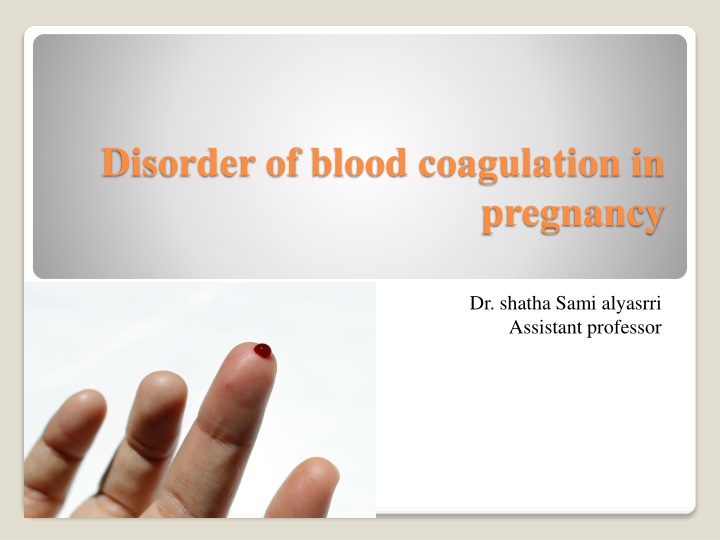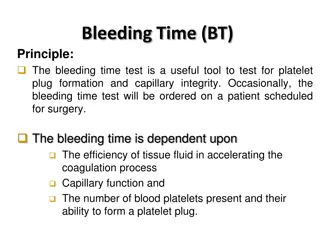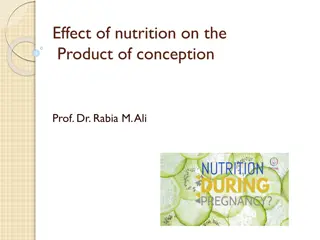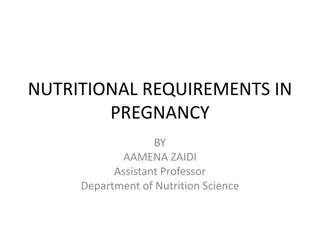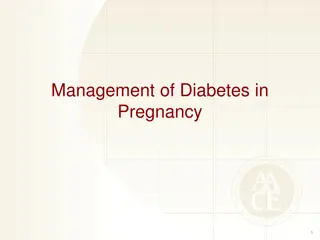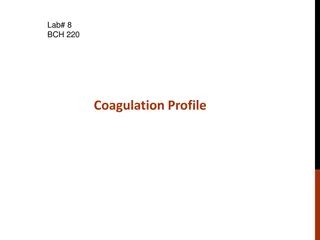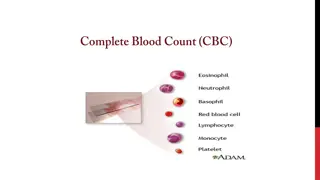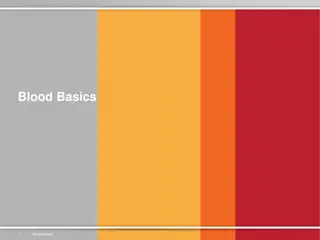Disorders of Blood Coagulation in Pregnancy and Delivery
Disorders of blood coagulation during pregnancy can pose risks such as bleeding disorders, inherited and acquired coagulation disorders, and hemophilia. It's essential to understand the implications, including genetic counseling, pre-pregnancy counseling, and prenatal diagnosis for carriers of hemophilia. Management by a multidisciplinary team is vital for the well-being of both mother and baby.
Download Presentation

Please find below an Image/Link to download the presentation.
The content on the website is provided AS IS for your information and personal use only. It may not be sold, licensed, or shared on other websites without obtaining consent from the author.If you encounter any issues during the download, it is possible that the publisher has removed the file from their server.
You are allowed to download the files provided on this website for personal or commercial use, subject to the condition that they are used lawfully. All files are the property of their respective owners.
The content on the website is provided AS IS for your information and personal use only. It may not be sold, licensed, or shared on other websites without obtaining consent from the author.
E N D
Presentation Transcript
Disorder of blood coagulation in pregnancy Dr. shatha Sami alyasrri Assistant professor
Bleeding disorders during pregnancy and delivery A. Inherited Vascular abnormalities Platelet disorders Coagulation disorders B.Acquired Thrombocytopenia Disseminated intravascular coagulation Acquired coagulation disorders Marrow disorders
Inherited disorders of plasma coagulation: 1. Hemophilia A (factor VIII deficiency). 2. Hemophilia B (factor IX). Both are X-linked recessive disorders, typical female carrier is not clinically affected. 3. Von will brand s disease.
Hemophilia Hemophilia A and B are sex-linked recessive incidence of one in 5000 and one in 30000 male births respectively. The genes for factor VIII(FVIII)and Factor IX(FIX) are located on the X-chromosome
in each pregnancy there is a 50% chance of having an affected son and a50% chance of having a daughter who will Also be a carrier of the condition.
Pre-pregnancy counseling Should be offered to carriers of hemophilia to discuss suitable reproductive options And methods of prenatal diagnosis Pregnancy in carriers of hemophilia should be Managed by a multidisciplinary team including an obstetrician ,hematologist and Anesthetist
1. The baseline factor level should be determined prepregnancy 2. The general health of women who are carriers for hemophilia should be optimized. 3. Genetic counseling should be provided to women at risk, ideally before pregnancy 4. Carriers of severe hemophilia should be offered pre implantation genetic diagnosis.
5. All carriers of severe hemophilia should be offered fetal sex determination by: Prenatal diagnosis: (i)Invasive methods: Chorionic villous sampling(CVS) 11-14 week amniocentesis;Cordocentesis
(ii) Non-invasive methods for determination of fetal sex by UltrasoundAssessment assessing free fetal DNA in the maternal circulation for the Presence or the absence of Y-chromosome-specific DNA sequence from 9weeks.
Management: Antenatally The risk of bleeding in early pregnancy and miscarriage is unknown in carriers of haemophilia, but there is evidence that the risk of antepartum bleeding from the genital tract after the 22nd week of pregnancy) is not increased. Carriers have their clotting factor level (FVIIIorFIX) checked At booking and at 28 and 34 weeks of gestation to allow appropriate management of labour and delivery and to assess the need for prophylactic treatment. For those women who do not attain normalization of factor VIII level during pregnancy, cover is required for delivery or invasive procedures with recombinant factor VIII or Desmopressin(DDAVV).
LABOUR: established the most recent factor VIII level if factor VIII level is normal in the third trimester no special maternal precautions are indicated. If low, DDAVP or recombinant factor VIII should be given under supervision of hematologist. If hemophilia is suspected in the fetus avoid scalp electrode or fetal blood sampling and vacuum. At time of delivery: cord blood should be sent for all male newborns for urgent factor VIII level . hemophilic neonate should receive a dose of recombinant factor VIII to minimize the risk of intracranial haemorrhage. IM injections should be avoided until hemophilia status is known. vitamin K can be orally.
postpartum management As factor VIII fall dramatically back to pre-pregnancy levels within 48 hours of delivery, there is increased risk of secondary PPH, recombinant factor VIII may need to be continued for several days after delivery.
Von willebrand disease (VWD): is a plasma protein Is the most common inherited bleeding disorder, both sexes are affected Main functionsVWF 1.stabilization of factor VIII 2.adherence of platelets to injured vessel walls.
Types of VWD *Type 1 is the most common and mildest form, present in approximately75 % of patients. It is associated with a quantitative deficiency of VWF * Type 2 the defect is qualitative. * Type 3 is the most severe.
Antenatal: VWD subtype should be detected before conception and patient's response to DDAVP should be evaluated. The diagnosis is not required as bleeding tendency is relatively mild. Majority of type I will normalize during pregnancy with no haemostatic support until the postnatal period. A Von Willebrand screen should be performed in each trimester and a clear plan for care in labour and postnatal period.
Labor and delivery: Women with severe VWD, delivery should be planned at a unit where the necessary expertise in the management of this disorder and resources for laboratory testing and clotting factor Women with type IVWD not require prophylactic Treatment for delivery Type2VWD, treatment is required for operative delivery or if there is perineal trauma Women Type3VWD require treatment for all types of delivery
Epidural anesthesia can be offered for use in women with type 1VWD It is not recommended for use in type2or3VWD Active Management of third stage should be practiced in women with VWD Tranexamic acid can also be used in the prevention or control of PPH Factor levels should be monitored post delivery and prophylaxis given to maintainVWFactivity And FVIII levels>50IUdL) for at least 3days, or5days following caesarean section. Tranexamic acid or COC pill should be considered to control prolonged and/or intermittent secondary PPH.
Postpartum If factor replacement is needed for delivery,continue this postnatal until risk of haemorrhage is decreased unless patient is a known DDAVP responder, in which case this can be administered IV or nasally. Type 3 can be diagnosed from cord blood after birth, it is almost impossible to diagnose milder forms of VWD in a neonate as VWF levels raise significantly during labour, therefore can mask these forms of disease. However there is no urgency in making diagnosis at birth as risk of bleeding in neonatal period is very low.
Disseminated intravascular coagulation a cascade of events which can vary in severity, and range from compensated state with only laboratory evidence of increased coagulation and fibrinolyic factor turnover *it is never primary, but always secondary
Manifestation: 1. Compensated state with no clinical manifestation but lab evidence of increased production and breakdown of coagulation factors. 2. Condition of massive uncontrollable haemorrhage with very low concentration of plasma fibrinogen, pathological raised levels of fibrin degradation products (FDP) and a variable degree of thrombocytopenia.
Obstetric conditions associated with DIC: 1.injury to vascular endothelium: pre-eclampsia. hypovolaemic shock. septicemia. cold injury(large amount of cold fluid). 2.release of thrombogenic tissue factors: placental abruption. amniotic fluid embolism. prolonged intrauterine fetal death. 3.production of procoagulant phospholipids: incompatible blood transfusion. septicemia.
Mild DIC may be controlled by adequate transfusion with stored blood and FFP. More FFP will be required in severe cases. FFP provides factors V and VIII,other labile coagulation factors and some antithrombin IIIa and fibrinogen. Cryoprecipitate (high fibrinogen content)and platelets may also be needed. After intial resuscitation , management will be dependent on repeated checks of the haemoglobin, plat. and coagulation status. Remember that stored blood contain thromboplastins and can exacerbate DIC once 6 units have been given. DIC will not settle until the cause resolves.
